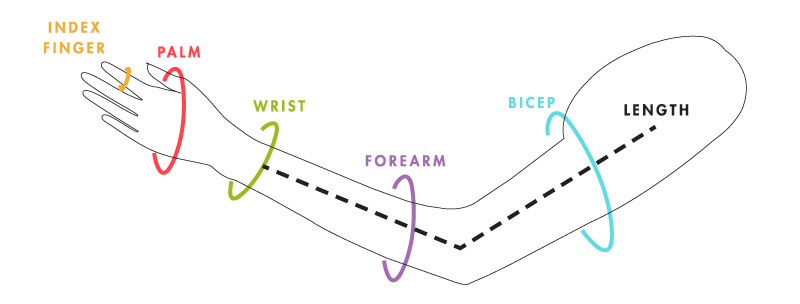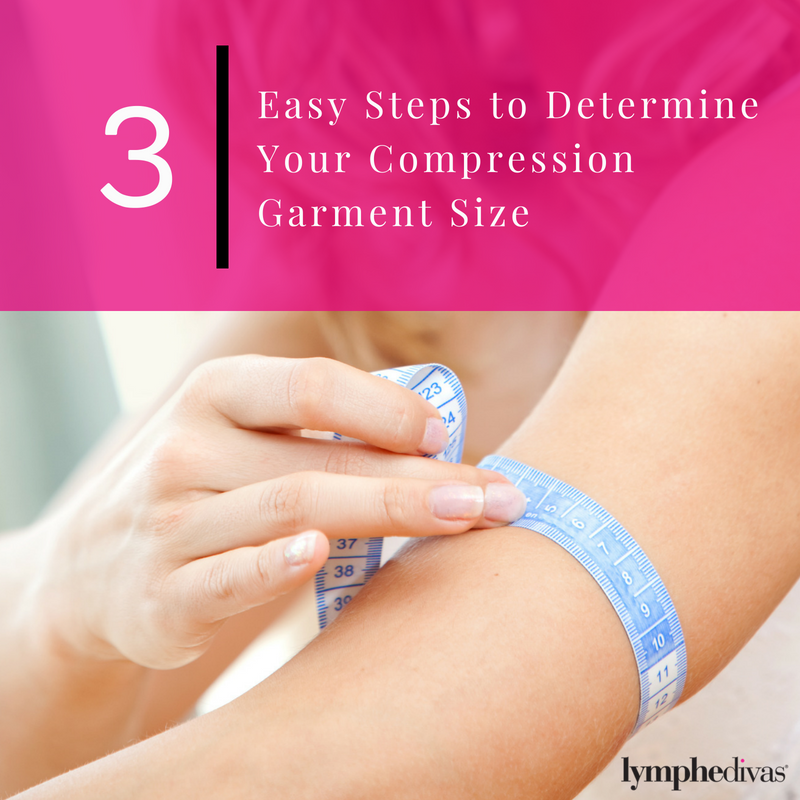For many patients, getting prescribed a compression garment to manage lymphedema or to use preventatively if they are at-risk for lymphedema will be their first experience in medical compression. There are three things you need to know before you can determine your size and make a compression garment purchase.
BEFORE YOU START MEASURING
- What garments do you need? As a minimum to manage arm lymphedema (or to reduce the risk), a compression arm sleeve is prescribed. An arm sleeve will provide compression from the wrist to the bicep, helping to move fluid toward the body. Then you need to determine whether you need a handpiece to wear with your arm sleeve. A gauntlet provides compression in the palm, and a glove provides compression in the fingers and palm. Our Medical Advisory Board believes that wearing a compression gauntlet or glove is essential to maintain proper graduated compression and to get the most benefit from wearing a medical graduated compression garment. A graduated compression garment works by helping to move fluid from an area of high compression to an area of lower compression. What we look for in a graduated compression garment is that the pressure is highest at the most distal point from the body and that it decreases as it goes up the arm. The risk of not wearing a hand compression garment is that there is no compression at the most distal point in the body (the fingers/palm).
- How much compression do you need to manage or reduce risk of lymphedema? This information is determined by the prescribing party for your compression garment. Whether it is your doctor, physical therapist or lymphedema therapist, they will assess your arm and determine whether a Class 1 (20-30mmHg) or Class 2 (30-40mmHg) level of compression is needed to manage your swelling or risk of swelling. As a rule of thumb Class 1 is the lower compression, and Class 2 is the higher, typically Class 1 is for preventative use and for mild lymphedema, and Class 2 is for more advanced lymphedema.
- Is there a fitting professional that can fit you for a compression garment? If you’re working with a lymphedema or physical therapist they should be able to take the necessary measurements and recommend a garment size and compression class. If you’d like to find a certified lymphedema therapist near you, please visit the LANA therapist locator. If working with a therapist is not an option, there is still an opportunity to work with a certified fitter, use our store locator to find a store location near you and give them a call to see if they have a fitter on staff that may be able to assist. A therapist or fitter will provide you with the assurance that the garment you’re getting is the correct fit, once you get your garment in, they will ask you to don the garment and look to make sure that the fabric is being distributed correctly and that there isn’t any issue. If working with a fitter isn’t an option, you can use the information below to find your size in LympheDIVAs garments.

HOW TO MEASURE
Step 1: Determine which measurements you need
Arm Sleeve Only
Please measure your wrist, forearm, bicep and arm length from the wrist to the top of the arm.
Arm Sleeve and Gauntlet
Please measure your palm, wrist, forearm, bicep and arm length from the wrist to the top of the arm.
Arm Sleeve and Glove
Please measure the circumference on your index finger, palm, wrist, forearm, bicep and arm length from the wrist to the top of the arm.
Step 2: Measure your arm according to our sizing chart diagram. Measuring your own arm may prove to be difficult, we recommend asking a partner or friend to help you measure. You will need a tape measure or a string and ruler to take your measurements. If you don’t need your garment urgently and would like a LympheDIVAs tape measure, send us a message.
First, relax and bend your arm slightly in the elbow. Your arm should not be completely straight, nor fully bent. With each measurement, pull the tape around your arm to the point of gentle tension.
Index Finger:
Let your fingers relax, measure the circumference of the knuckle on your index finger.
Palm:
Measure the top of your palm, just under your knuckles.
Wrist:
On your wrist, measure over the little bone on the outside.
Forearm:
Measure the fullest part of your forearm.
Bicep:
Measure the fullest part halfway between your elbow and your armpit. If you have any extra skin here, gather it together as much as possible. You should hold the tape a bit tighter here so that all your skin is encircled evenly.
Length:
Measure your arm length from the top of your arm to your wrist.
Step 3: Input your measurements into the Fitter’s Aid app to get a sizing recommendation. The Fitter’s Aid will provide all your sizing options, with the most viable option at the top. You can also select each recommendation and see the approximate compression you’d get at each measuring point. You can use this information to make your sizing decision. If you need help using the Fitter’s Aid or prefer a personal touch, please contact us with your measurements, and we can make a sizing recommendation. Be sure to let us know which garments you need (arm sleeve, gauntlet, and/or glove) and what compression class you need in addition to your measurements.
We often get questions about converting a garment size from a garment from a different manufacturer to our size. Unfortunately, the only accurate way to make sure that you have a garment that manages your swelling (or risk) effectively is to follow the steps above and using your measurements. There is no crossover between sizing from various manufacturers.
For many, getting the right garment and size may not come on the first try. Typically, a garment is purchased, tried on and then shown to a fitter, therapist, or doctor to ensure that proper fit and graduated compression is achieved. Do not get discouraged if it takes a couple of rounds of returns and exchanges to get your sizing just right. If you are not working with a fitter, therapist, or doctor and would like to discuss your fit with us, we are happy to connect with you, please note that our customer service team are not medical professionals and can only offer insight into the fit of LympheDIVAs brand garments. A fitter, doctor, or therapist may give a more comprehensive picture and can cross-reference multiple brands to find the garment that will help achieve optimal results.
